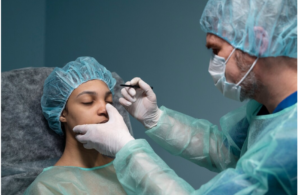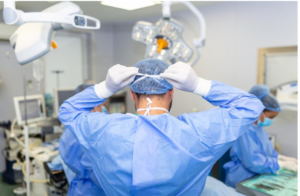Eyelid surgery, also known as blepharoplasty, is a transformative cosmetic surgical procedure aimed at rejuvenating the appearance of the eyes by addressing issues such as drooping eyelids, excess skin, or puffiness. This intricate procedure requires a thorough understanding to grasp its nuances and potential outcomes. For more information on advanced facial rejuvenation techniques, including eyelid surgery, visit this page https://britishfaceclinic.com/deep-plane-facelift/
Types of Eyelid Surgery

There are several nuanced types of eyelid surgery, each tailored to address specific concerns with precision and expertise:
Upper Eyelid Surgery (Blepharoplasty)
This procedure focuses on correcting sagging or drooping upper eyelids, which not only affect aesthetics but can also obscure vision and lead to discomfort.
Lower Eyelid Surgery (Lower Blepharoplasty)
Lower eyelid surgery targets under-eye bags, puffiness, or wrinkles, restoring a more youthful and refreshed appearance to the lower eye area.
Asian Eyelid Surgery (Double Eyelid Surgery)
A specialised procedure aimed at creating a natural-looking crease in the upper eyelid for individuals with monolids, enhancing the definition and symmetry of the eyes.
Candidates for Eyelid Surgery
Eyelid surgery is typically recommended for individuals experiencing:
Functional Issues
Those with drooping eyelids that obstruct vision, causing difficulty in daily activities such as reading or driving.
Cosmetic Concerns
Individuals are bothered by excess skin or fat deposits around the eyes, which can contribute to a tired or aged appearance.
Desire for Enhancement
Individuals seeking cosmetic enhancement to improve the aesthetics of their eyelids and achieve a more youthful and rejuvenated look.
Preparing for Eyelid Surgery
Before undergoing eyelid surgery, comprehensive preparation is essential:
Consultation
Patients consult with a qualified plastic surgeon to discuss their goals, concerns, and expectations for the procedure.
Evaluation
Medical evaluations and tests are conducted to ensure that the patient is a suitable candidate for eyelid surgery and to identify any underlying health issues that may affect the outcome.
Pre-Operative Instructions
Patients receive detailed instructions regarding pre-operative preparations, including medication management, dietary guidelines, and lifestyle adjustments to optimise surgical outcomes.
The Eyelid Surgery Procedure
During the eyelid surgery procedure, meticulous attention is paid to every detail to achieve optimal results:
Anaesthesia
Anaesthesia is administered to ensure patient comfort throughout the procedure, with options ranging from local anaesthesia with sedation to general anaesthesia depending on the extent of surgery.
Incisions
Precise incisions are made along the natural creases of the eyelids or inside the lower eyelid to minimise visible scarring.
Tissue Modification
Excess skin, fat, or muscle tissue is carefully removed or repositioned to address specific concerns such as drooping eyelids, under-eye bags, or puffiness.
Closure
Incisions are meticulously closed using sutures or tissue adhesives to facilitate optimal healing and minimise scarring.
Recovery Process
Following eyelid surgery, patients undergo a comprehensive recovery process to ensure optimal healing and results:
Immediate Post-Operative Care
Patients receive post-operative care instructions and are monitored closely in the recovery room to manage any immediate discomfort or complications.
Swelling and Bruising
Swelling and bruising around the eyes are common in the initial days following surgery and gradually subside over the following weeks.
Follow-Up Appointments
Scheduled follow-up appointments with the surgeon are essential to monitor the healing process, assess surgical outcomes, and address any concerns or complications.
Resumption of Activities
Patients gradually resume normal activities, including work and light exercise, as advised by the surgeon, with full recovery typically achieved within a few weeks to months.
Risks and Complications
While eyelid surgery is generally considered safe, it is essential to be aware of potential risks and complications, which may include:
Anaesthesia Risks
Adverse reactions to anaesthesia, though rare, can occur and are carefully monitored by the surgical team.
Bleeding and Infection
Post-operative bleeding or infection may occur, necessitating prompt medical attention and intervention.
Scarring and Asymmetry
While efforts are made to minimise scarring and achieve symmetrical results, individual healing responses may vary, leading to visible scarring or asymmetry in rare cases.
Dry Eyes or Irritation
Some patients may experience temporary dryness or irritation of the eyes following surgery, which can typically be managed with lubricating eye drops or ointments.
Results and Expectations

The results of eyelid surgery, particularly when performed by skilled professionals in London, are often transformative, enhancing the appearance of the eyes and rejuvenating the overall facial aesthetic. While initial results are visible shortly after surgery, final outcomes become apparent as swelling subsides and tissues settle into their new position. It is important for patients to maintain realistic expectations regarding the extent of improvement achievable through surgery and to understand that individual results may vary based on factors such as skin elasticity, healing response, and surgical technique. Choosing a reputable clinic for eyelid surgery in London ensures that patients receive expert care and achieve the best possible outcomes.
Conclusion
In conclusion, eyelid surgery is a highly effective cosmetic procedure that can significantly enhance the appearance of the eyes and rejuvenate the overall facial aesthetic. By understanding the intricacies of the procedure, its potential outcomes, and associated risks, individuals can make informed decisions and embark on their journey to achieving a more youthful, refreshed, and confident appearance under the guidance of a qualified and experienced plastic surgeon.
In addition to the transformative effects on appearance, eyelid surgery can also improve functional aspects such as peripheral vision obstruction, contributing to an enhanced quality of life. Moreover, the decision to undergo eyelid surgery should be made after thorough research, consultations, and consideration of personal goals, ensuring a positive and fulfilling experience with long-lasting results.


